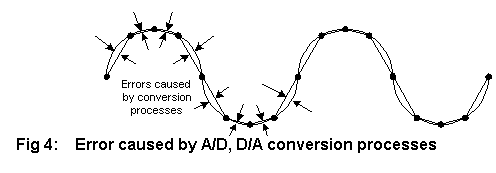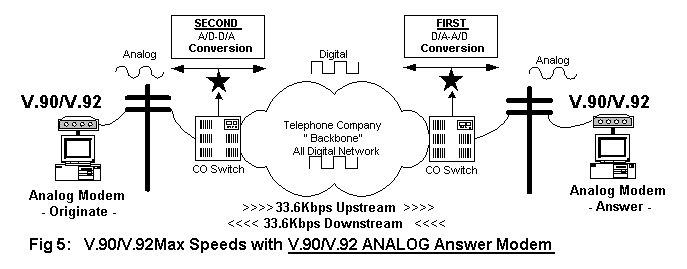56Kbps Speed Limits
Floyd Kling
Modems use the same telephone networks that we all use for our voice. These networks are optimized for your voice. Modems must adapt to these networks. Obtaining high speeds on these voice circuits has speed limits.
On today's modern telephone networks, once your call goes into the phone company, your <voice or modem> signal is immediately digitized, or converted, into digital signals to be more easily handled by the phone company’s equipment. (Fig 1).

When your call comes out of the network at the other end, these signals are converted back to analogue so the person at the other end can hear the voice. The phone company treats modem signals the same as voice.
Converting voice (analogue) to digital signals
The phone companies equipment can transport allot more information when it is in digital format than if it is analogue, or 'voice level' format, so they convert your voice to digital signals as soon as it enters the network.
The Analogue to Digital (A/D) conversion process assigns binary numbers to certain points on the analogue signal. (Fig 2) These points are assigned at the sampling rate speed assigned by the Telco equipment.
Note that since the original analogue signal is ‘linear’, there are potentially an infinite number of points to convert, but due to the limit on the telephone company’s equipment sampling rate, only a limited amount of points are converted.

The same thing happens at the other end, but in reverse, the digital numbers are re-assembled and converted (as closely as possible) back into the original analogue signals so you can hear them. (Fig 3) The phone companies equipment can transport allot more information when it is in digital format than if it is analogue, or 'voice level' format.

The problem is, each conversion is not “Perfect” and a small amount of the original signal is lost with each conversion. You cannot hear this loss, but modems trying to connect at higher and higher speeds need this lost information. (Fig 4)

The conversion processes limits the actual amount of data that can be sent thorough the network. The dial up network was designed to support voice and voice uses a small bandwidth – typically 4khz.
Voice is very forgiving to conversion errors because our ears cannot hear the small imperfections caused by the conversions. Higher speed analogue modems need as much of the original signal as possible. 56Kbps analogue modems are close to the theoretical limits of a voice channel telephony system and every little bit counts.
What are the ‘REAL’ speeds available when using V.90 or V.92?
The first thing to ask is whether ANSWER modem is analogue or digital. If the ANSWER modem is analogue, there are two conversion processes. That second conversion process prohibits PCM modulation. Of course, V.90/92 speeds need PCM. This is true regardless whether either the originating or answering modems are V.90 or V.92. (Fig 5) The speeds indicated below are the maximum under ideal conditions – your actual speeds could vary widely.

If we eliminate one of these two conversion processes, PCM would be available and we would be able to run at higher speed. With a digital modem at the ANSWERING end, we can avoid one of these conversion processes and avoid some of this lost information.
On the digital modem (ISP) side, which is almost always the ANSWERING side, the digitized signals are fed directly into their 'digital' modems' and processed without the 2nd digital-to-analogue conversion.
ISP's modems do not perform D/A conversions because these modems are connected directly to Telephone Company's digital equipment. (Fig 6) The speeds indicated below are the maximum under ideal conditions – your actual speeds could vary widely.

ISP's typically do not use voice modems. Today, they have high-speed digital connections from the Phone Company. These are called T1's (1.5Mbps) or DS3's (45Mbps) or even higher speed connections. In this way, the ISP can handle many more customer connections in a much smaller space with allot less wires.
Since V.92 modems became available, upstream speeds are even greater because they can use upstream PCM. Only V.90 and V.92 modems use PCM modulation. PCM allows the speeds to go above 33.6kbps. 33.6kbps (V.34) modems and below use the older, but very stable QAM modulations.
V.90 has PCM only in the downstream mode, but V.92 added PCM in upstream direction also. (Fig 7) The speeds indicated below are the maximum under ideal conditions – your actual speeds could vary widely.

This is worth saying again as a reminder: a “rule of thumb’ to determine the max speed of your 56K modem, is to ask the question “Is the ANSWER modem analogue or digital?”
If the ANSWER modem is an analogue modem, the maximum speed of the connection is 33.6kbps regardless whether the originating modem is V.90 or V.92.
Home to Home (analogue modem to another analogue modem) … sorry, but top speed is 33.6Kbps on your 56K modems... (V90 and V92's are considered 56K modems)
-END-